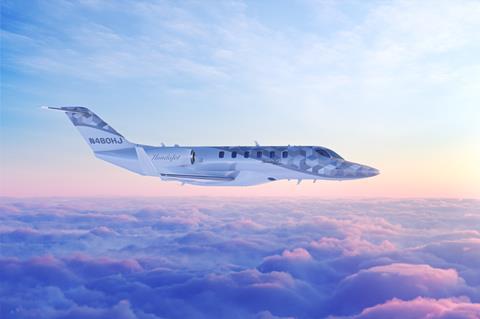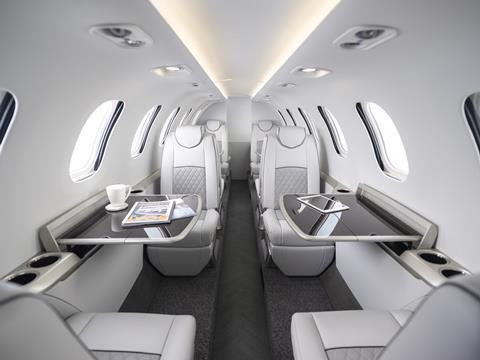Honda Aircraft is finalising the supply chain for its proposed HondaJet 2600 as the airframer seemingly moves closer to an official launch of the new aircraft.
Chief executive Hideto Yamasaki says the manufacturer will in June hold a ”supplier conference” at its site in Greensboro, North Carolina, where it “will be talking about the commercialisation” of the 2600, ahead of announcements at the NBAA show in October.
Yamasaki, speaking on 23 May, said the meeting is a step toward firming up details of the 2600’s supplier base and production ahead of advancing with a more aggressive marketing campaign for the business jet, which would straddle the light and midsize categories.

“We will have all the suppliers confirmed, sitting together,” says Yamasaki. “Talking to the suppliers – that, to us, means that [the programme] is happening.”
Yamasaki stresses that Honda Aircraft has not yet launched the development programme but his stance is notably confident toward a product he says will build on the success of the current HA-420 light jet and carry the company into the future.
“[The 2600] was a concept,” he says. “But now – before this announcement [at] NBAA – we see that confirming with the suppliers means this company is really serious.”
He says details to be disclosed at NBAA could relate to naming, pricing and marketing, but offers no more specifics.
Honda Aircraft first revealed the 2600 in 2021, teasing a concept that would take the company into a significantly larger size category.
It has described the 2600 as the “first-ever transcontinental light jet” and the “longest-range single-pilot business aircraft”.
Honda Aircraft’s provisional specifications tout an aircraft able to carry up to 11 people, including two pilots, cruise at 450kt (834km/h) and have sufficient range for transcontinental North American flights. In comparison, the HA-420 is a six-passenger light jet with range of about 1,550nm.
Yamasaki says the new jet will build on the design and success of the HA-420, sharing a similar fuselage and structural layout, such as its distinctive over-wing engines, for example. “We are going to use the fundamental 420 as a base to make the derivatives,” he says.
But when the 2600 might arrive is not clear. The question of which engine might power the new type also remains unanswered, though Honda Aircraft has a long-standing partnership with GE Aerospace, jointly producing the 2,050lb (9.1kN)-thrust HF-120 engines that equip the HA-420.
The 2600 would seemingly compete with business jets like Embraer’s Phenom 300E (carrying 10 passengers over routes of 2,010nm), the Cessna Citation CJ4 (10 passengers/2,165nm) and Citation Latitude (nine passengers/2,700nm).

Yamasaki became Honda Aircraft chief in 2022, taking over from long-time leader Michimasa Fujino, an engineer by training who helped the fledgling firm establish itself as a player in the ultra-light-jet niche. The company has faced production and financial issues but still managed to make the HA-420 a commercial success, with some 230 of the type in service.
Yamasaki says he is shaking things up, bringing a business background to the firm.
“I am changing everything,” says Japan-born Yamasaki, who joined Honda in 1985 and worked most of his career in the company’s automotive business. “We have shifted a start-up company to a real commercial business structure.”
He aims to right Honda Aircraft’s finances – the division lost Y25.7 billion ($185 million) in its recent fiscal year – and to better leverage the assets of the broader Honda company, specifically by collaborating more closely with its automotive divisions.
“For the 2600 concept, we haven’t changed that much from the exterior side but we are now changing a little bit more of the interior,” he says.
Honda Aircraft’s latest update of its HA-420 – the Elite II variant – is making its EBACE debut at this year’s show. The company rolled out the enhancement last year, giving the jet slightly more range and introducing modern cockpit features including auto-throttle and auto-land capabilities.
On 23 May, Honda Aircraft revealed that the Elite II had been approved by the European regulator, building on US certification last year.


























